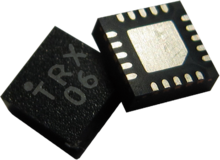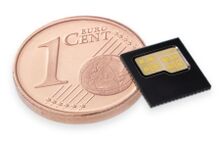Radar Front End ICs
Contents
1 24 GHz Transceivers
| Front End | Status of IC | Package | Antenna Solutions | Evaluation / Sensor | Typical Applications |
|
Single Channel Transceiver / Receiver |
|
Range Finding, Level Probing, | |||
|
Multi Channel Transceiver
|
|
Level Probing, Flow Rate Measurement, |
(1) Qualified after JEDEC; MSL
1.1 TRX_024_006
The IC is an integrated transceiver circuit for the 24-GHz ISM band in the frequency range 24.0 GHz – 24.25 GHz. It includes a low-noise amplifier (LNA) with gain control, quadrature mixers, a poly-phase filter, a voltage-controlled oscillator with band switching, and a divide-by-32 circuit. The receiver can be powered down if PWR_RX pin is supplied with 0 V. The gain of the receiver can be digitally controlled by Vct pin: Vct = 3.3 V sets the receiver in high gain mode, Vct = 0 V sets the receiver in low gain mode. The output power of the transmitter can be controlled by the pwr1 input. The IC is fabricated in SiGe BiCMOS technology[1] using the bipolar part and the CMOS part.
The TRXˍ024ˍ006 can be used in wireless communication systems and radar systems for the ISM band from 24.0 GHz to 24.25 GHz and for UWB applications between 23 GHz and 26 GHz.
For more information please see TRX_024_006 datasheet.
Besides the TRXˍ024ˍ006, an IC variant with a divider division ratio of 1:8 is available as TRX_024_007, please see section below.
1.2 TRX_024_007
The IC is an integrated transceiver circuit for the 24-GHz ISM band in the frequency range 24.0 GHz – 24.25 GHz. It includes a low-noise amplifier (LNA) with gain control, quadrature mixers, a poly-phase filter, a voltage controlled oscillator with band switching, and a divide-by-8 circuit. The receiver can be powered down if PWR_RX pin is supplied with 0 V. The gain of the receiver can be digitally controlled by Vct pin: Vct = 3.3 V sets the receiver in high gain mode, Vct = 0 V sets the receiver in low gain mode. The output power of the transmitter can be controlled by the pwr1 input. The IC has been fabricated in SiGe BiCMOS[2] technology by using the bipolar part and the CMOS part.
The TRXˍ024ˍ007 can be used in radar systems and wireless communication systems for the ISM band from 24.0 GHz to 24.25 GHz and for UWB applications between 23 GHz and 26 GHz.
For more information please see TRX_024_007 datasheet.
Beside the TRXˍ024ˍ007, an IC variant with a divider division ratio of 1:32 is available as TRXˍ024ˍ006.
1.3 FAQ: TRX_024_00*
Please see FAQs page for frequently asked questions.
2 60 GHz Transceivers
| Front End | Status of IC | Package | Antenna Solutions | Evaluation / Sensor |
|
Single Channel (Monostatic) Transceiver
|
|
|
||
|
Multi Channel Transceiver
|
|
SiRad MIMO 60 GHz (under development) | ||
|
Multi Channel Transceiver
|
|
SiRad MIMO 60 GHz (under development) |
(1) Under investigation
(2) Coupler on chip; one antenna for Tx and Rx
2.1 TRX_060_11
The IC is an integrated transceiver circuit for the 60 GHz ISM band operating in the frequency range of 58.3 GHz - 63.9 GHz. It includes a low-noise-amplifier (LNA) with gain control, quadrature mixers, poly-phase filter, a power amplifier (PA) with gain control, Voltage Controlled Oscillator with digital band switching, and divide-by-32 circuit. The output power of the transmitter can be controlled by pwr0 and pwr1 inputs. The IC is fabricated in SiGe BiCMOS technology by using the bipolar part and the CMOS part [3].
The main use of the transceiver IC is in radar systems for the ISM band from 57 GHz to 64 GHz. FMCW is the preferred radar principle to be used.
2.2 TR2_060_10
The IC is an integrated transceiver circuit for the 60 GHz ISM-band operating in the frequency range of 58.3 GHz – 63.9 GHz. It has one transmit and two receive channels. It includes a low-noise-amplifier (LNA) with gain control, quadrature mixers, poly-phase filter, a power amplifier (PA) with gain control, Voltage Controlled Oscillator with digital band switching, and divide-by-32 circuit. The output power of the transmitter can be controlled by “TXgain” input. The IC is fabricated in SiGe BiCMOS technology [4].
The main use of the transceiver IC is in radar systems for the ISM-band from 57 GHz to 64 GHz. FMCW is the preferred radar principle to be used. It can be used in radar systems with angular resolution (monopulse principle).
3 120 GHz Transceivers
| Front End | Status of IC | Package | Antenna Solutions | Evaluation / Sensor | Typical Applications |
|
Single Channel Transceiver |
|
Range Finding, Interface Measurement, | |||
|
Single Channel Transceiver |
|
|
Range Finding, Level Probing, | ||
|
Ultra Wideband Single Channel Transceiver
|
|
|
Pressure Measurement, Temperature Measurement, | ||
|
Multi Channel Transceiver
|
|
|
SiRad Easy® (6) |
(1) Qualified after JEDEC; MSL
(2) Under investigation
(3) Incl. lens (Si / 3D-printed)
(4) Patented assembly solution
(5) In silicon, completely moulded
(6) Under Development
3.1 TRX_120_001
The RFE is an integrated transceiver circuit for the 122-GHz ISM band with antennas in the QFN 8x8 package. It includes a low-noise amplifier (LNA), quadrature mixers, a poly-phase filter, a voltage-controlled oscillator, divide-by-32 outputs, and transmit and receive antennas. The RF signal from the oscillator is directed to the RX path via buffer circuits. The RX signal is amplified by the LNA and converted to the baseband by two mixers with a quadrature local oscillator (LO). The 120-GHz LO has four analog tuning inputs with different tuning ranges and tuning slopes. The tuning inputs can be combined to obtain a wide frequency tuning range. The analog tuning inputs together with an integrated frequency divider and external fractional-N PLL can be used for frequency modulated continuous wave (FMCW) radar operation. With fixed oscillator frequency it can be used in continuous wave (CW) mode. Other modulation schemes are possible as well by utilizing analog tuning inputs. The IC is fabricated in SG13S SiGe BiCMOS technology [5].
The main application field of the 120-GHz transceiver radar frontend is in short-range radar systems with a range up to some 10 meters. By using dielectric lenses, the range can be increased considerably. The RFE can be used in FMCW mode as well as in CW mode. Although the chip is intended for use in the ISM band 122 GHz - 123 GHz, it is also possible to extend the bandwidth to the full tuning range of 7 GHz.
3.2 TRX_120_002
The radar-front end (RFE) is an integrated transceiver circuit for the 120 GHz ISM band with antennas on-chip in a QFN 5x5 package. It includes a low-noise amplifier (LNA), quadrature mixers, poly-phase filter, voltage-controlled oscillator with digital band switching, divide-by-32 outputs, and transmit and receive antennas. The RF signal from the oscillator is directed to the RX path via buffer circuits. The RX signal is amplified by an LNA and converted to baseband in two mixers with quadrature LO. The 120 GHz oscillator has three analog coarse tuning inputs and one analog fine-tuning input. The tuning inputs can be combined to obtain a large tuning range and large bandwidth. The analog tuning inputs together with an integrated frequency divider and external fractional-N PLL can be used for frequency modulated continuous wave (FMCW) radar operation. With fixed oscillator frequency it can be used in continuous wave (CW) mode. Other modulation schemes are possible as well by utilizing analog tuning inputs. The IC is fabricated in IHP SG13S SiGe BiCMOS technology [6].
The main application field of the 120 GHz transceiver RFE is in short-range radar systems. With the use of dielectric lenses, the range can be increased considerably. The RFE can be used in FMCW mode as well as in CW mode. Although the chip is intended for use in ISM band 122 GHz - 123 GHz, it is also possible to extend the bandwidth to the full tuning range of almost 7 GHz.
3.3 FAQ: TRX_120_00*
Please see FAQs page for frequently asked questions and TRA_120_002 SiRad front end datasheet [7].
4 300 GHz Transceivers
| Front End | Status of IC | Package | Antenna Solutions | Evaluation / Sensor | Typical Applications |
|
Ultra Wideband Single Channel Transceiver
|
|
|
|
Pressure Measurement, Temperature Measurement, |
(1) Under investigation
(2) Incl. lens (Si / 3D-printed)
(3) In silicon, completely moulded

